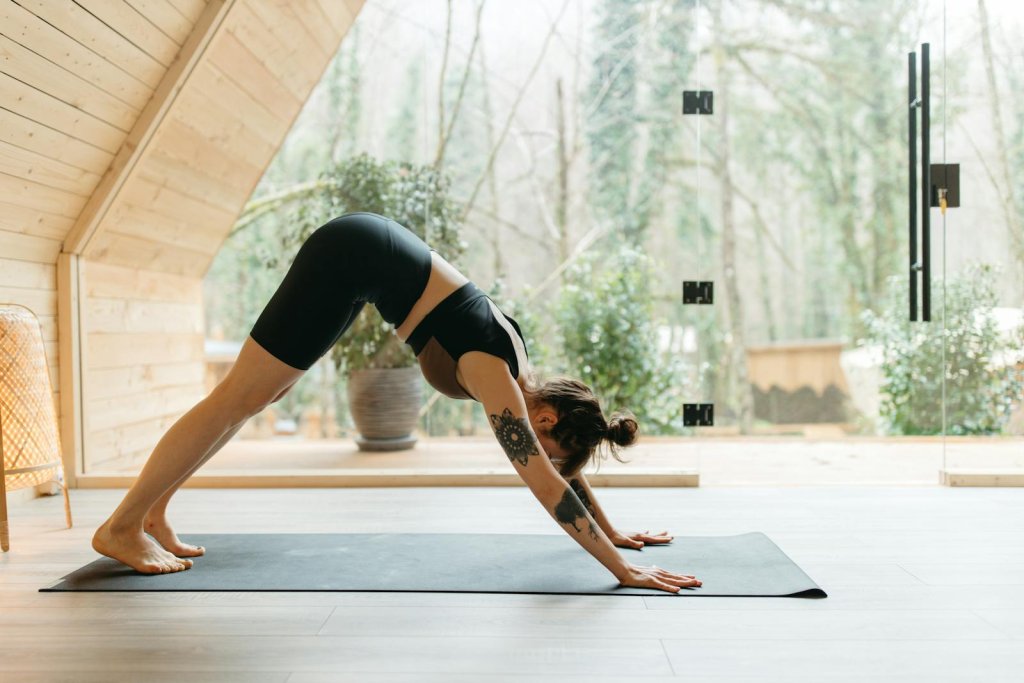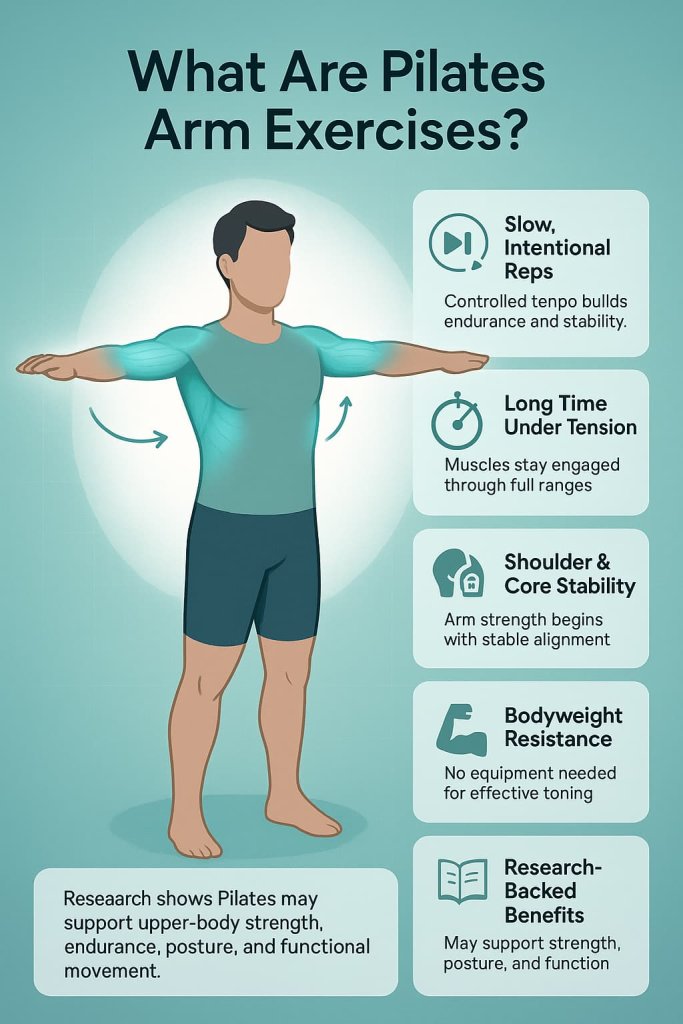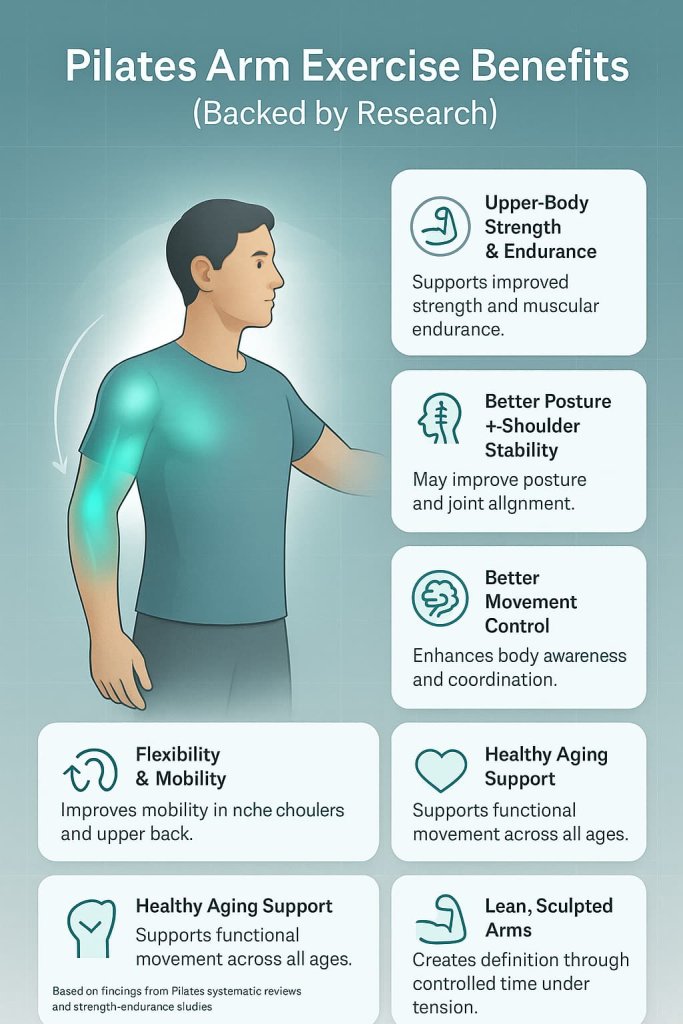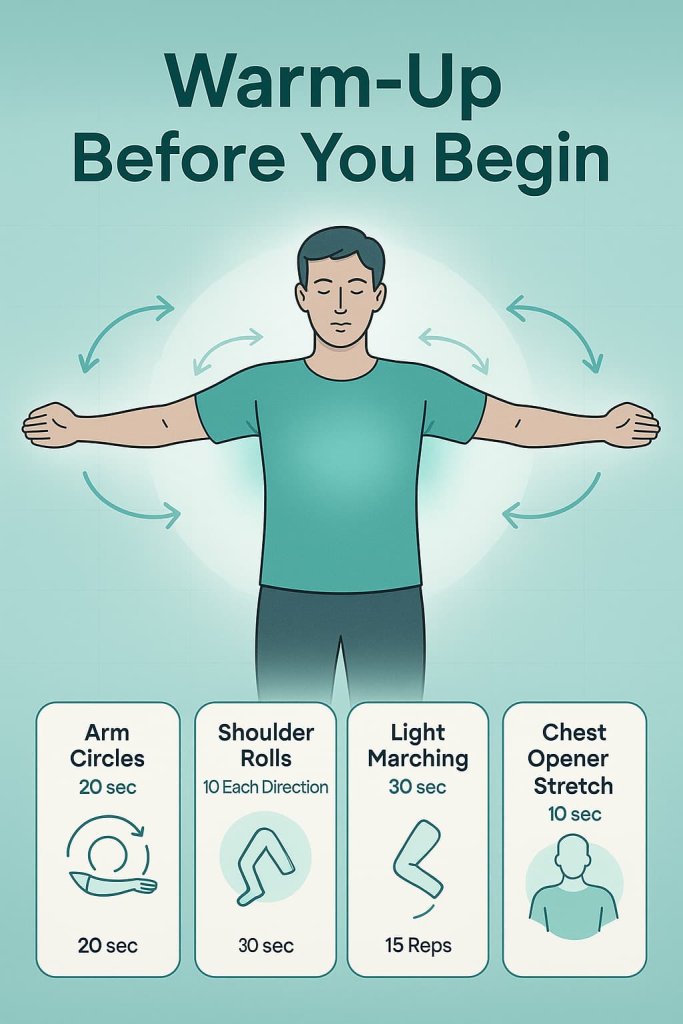Pilates arm exercises help you build lean, sculpted arms using slow, controlled movements that don’t require heavy weights. These targeted moves strengthen your shoulders, triceps, biceps, and upper-back muscles through bodyweight leverage and posture-focused control.

Understanding how Pilates shapes the arms is important because the method emphasizes precision, stability, mobility, and time under tension—all of which support long-term strength and definition. These exercises can be done at home, require no equipment, and fit any fitness level.
In this guide, you’ll learn the best Pilates arm moves, how to perform them safely, how they work, and how often to include them in your weekly routine. You’ll also find research-backed benefits and helpful FAQs.
What Are Pilates Arm Exercises?
Pilates arm exercises are upper-body strengthening movements that use bodyweight, controlled tempo, posture alignment, and core engagement to activate your shoulder girdle, triceps, biceps, and upper back.

These exercises rely on:
- Slow, intentional reps
- Long time under tension
- Shoulder stability and core activation
- Bodyweight resistance instead of heavy loads
Scientific reviews show Pilates may improve upper-body strength, muscular endurance, posture, and functional fitness, especially in beginners and older adults (Source: Journal of Bodywork & Movement Therapies, 2023).
Pilates Arm Exercise Benefits
You can safely highlight the following evidence-supported benefits:

- Supports upper-body strength and endurance
- May improve posture and shoulder stability
- Enhances movement control and body awareness
- Improves flexibility and mobility
- Supports healthy aging and functional fitness
- Helps create lean, sculpted arms through controlled time under tension
Are Pilates Arm Exercises Effective Without Weights?
Yes. Pilates arm exercises can help you build lean muscle definition and upper-body endurance without weights. The method uses:

- Prolonged time under tension
- Shoulder-stability demands
- Slow eccentric control
- Full-range arm movements
- Bodyweight loading in planks and dips
These principles create enough resistance to challenge the arms safely at home.
If you want additional challenge, light dumbbells or resistance bands may be used later.
Warm-Up Before You Begin
A proper warm-up prepares your shoulders, elbows, and wrists for upper-body work. Try this 2–3 minute sequence:

- Arm circles – 20 seconds
- Shoulder rolls – 10 each direction
- Light marching – 30 seconds
- Elbow flex/extend – 15 reps
- Chest opener stretch – 10 seconds
Warm muscles move better and reduce strain.
13 Best Pilates Arm Exercises (No Weights Needed)
Below are the best bodyweight Pilates arm exercises, each explained with how to perform them, what muscles they target, and why they work.
1. Arm Circles
Why it works:
Arm circles use continuous, low-load movement to build endurance in the shoulders and upper back. The long time under tension strengthens stabilizing muscles, improves joint mobility, and supports better posture. This classic Pilates warm-up also activates the rotator cuff to prepare the upper body for harder work.
Muscles worked:
Deltoids, rotator cuff, upper back (mid and lower traps)
How to do it:
- Stand tall with arms extended out at shoulder height.
- Create small, controlled circles forward for 20–30 seconds.
- Reverse direction for another 20–30 seconds.
- Keep the core engaged, ribs stacked, and shoulders relaxed.
Trainer Tip:
The smaller and slower the circles, the harder the shoulders work—avoid swinging your arms.
2. Pilates Boxing
Why it works:
Pilates Boxing blends upper-body endurance training with core rotation control. The alternating punches increase shoulder stamina while teaching the torso to stabilize against movement, which enhances overall posture and upper-body tone.
Muscles worked:
Shoulders, biceps, obliques, transverse abdominis
How to do it:
- Stand with soft knees and arms bent as if guarding your face.
- Extend one arm forward in a controlled “punch.”
- Alternate arms smoothly for 30–45 seconds.
- Keep shoulders low and chest open throughout.
Trainer Tip:
Imagine punching through thick water—this increases tension without adding weight.
3. Serving Tray
Why it works:
This Pilates staple strengthens the front of the shoulders and biceps while training the postural muscles that stabilize the upper arm. Keeping palms lifted creates constant tension that supports lean muscle definition.
Muscles worked:
Anterior deltoids, biceps, deep core stabilizers
How to do it:
- Stand or sit tall with elbows bent at 90 degrees, palms facing upward.
- Extend arms forward while maintaining elbow height.
- Draw arms back in without letting the elbows drop.
- Perform 12–15 slow, controlled reps.
Trainer Tip:
Keep your palms “serving upward” the entire time to maximize biceps activation.
4. Triceps Dips (Chair or Mat)
Why it works:
Bodyweight triceps dips effectively isolate the back of the arms using your own leverage. The move strengthens the triceps while also improving shoulder extension strength—an area most people undertrain.
Muscles worked:
Triceps, chest, front shoulders
How to do it:
- Sit on a sturdy chair edge with hands beside hips.
- Slide forward and bend elbows straight back to lower your body.
- Press through the palms to lift back up.
- Perform 8–12 reps with controlled lowering.
Trainer Tip:
Avoid letting your shoulders creep toward your ears—keep them pulled down and stable.
5. Plank Shoulder Taps
Why it works:
This anti-rotation plank variation forces the shoulders, triceps, and core to stabilize the body with each tap. It improves shoulder control, increases upper-body endurance, and trains the body to remain steady during movement.
Muscles worked:
Shoulders, triceps, core, obliques
How to do it:
- Begin in a strong high plank position.
- Tap right hand to left shoulder, then switch sides.
- Continue for 20–30 seconds without rocking the hips.
- Maintain a straight line from head to heels.
Trainer Tip:
Move slower than you think—speed makes it easier, not harder.
6. Modified Triceps Push-Up
Why it works:
By lowering the intensity (knees down), this variation allows greater control and better isolation of the triceps. It reduces wrist strain and encourages proper alignment for beginners or anyone focusing on technique.
Muscles worked:
Triceps, chest, core
How to do it:
- Start on knees with hands under shoulders.
- Lower your chest while keeping elbows tight to the ribcage.
- Press back up with a slow, steady motion.
- Perform 8–12 reps.
Trainer Tip:
Think about “pulling” your elbows toward your hips—this helps isolate the triceps.
7. Downward Dog to Plank Flow
Why it works:
This dynamic Pilates flow loads the shoulders during the plank phase and stretches them during downward dog. The controlled transition improves shoulder mobility, upper-back strength, and core activation.
Muscles worked:
Shoulders, triceps, upper back, core
How to do it:
- Start in a full plank.
- Shift into downward dog, lifting hips upward.
- Flow back forward to plank with slow control.
- Repeat 8–10 times.
Trainer Tip:
Press firmly through your palms in downward dog to deepen shoulder engagement.
8. Swimming (Prone Arm Lifts)
Why it works:
Swimming strengthens the entire posterior chain, improving posture, shoulder stability, and upper-back definition. This helps create the lifted, long look associated with Pilates.
Muscles worked:
Upper back, rear deltoids, spinal extensors
How to do it:
- Lie on your stomach with arms and legs extended.
- Lift opposite arm and leg simultaneously.
- Alternate sides in a swimming rhythm for 20–30 seconds.
- Keep chest slightly lifted without straining the neck.
Trainer Tip:
Keep your gaze down toward the mat to maintain optimal spinal alignment.
9. Reverse Fly (Prone or Standing)
Why it works:
Reverse flies target the often-underused upper-back muscles that support upright posture. Better posture visually enhances arm definition and helps balance shoulder strength.
Muscles worked:
Rear deltoids, upper back, rhomboids, mid traps
How to do it:
- Stand hinged at the hips or lie face down.
- Lift arms outward into a wide “T” shape.
- Lower with slow control without collapsing the chest.
- Perform 10–12 reps.
Trainer Tip:
Think about squeezing your shoulder blades together gently at the top.
10. Pilates Push-Up
Why it works:
This variation emphasizes slow, precise control rather than speed or maximum reps. It strengthens the arms while improving core alignment, shoulder stability, and total-body coordination.
Muscles worked:
Chest, triceps, shoulders, core
How to do it:
- Stand tall and roll down through the spine.
- Walk hands out to plank.
- Perform 1–3 slow push-ups.
- Walk back and roll up.
- Repeat 3–5 cycles.
Trainer Tip:
Keep elbows angled diagonally instead of flaring wide to protect the shoulders.
11. Leg Pull Front
Why it works:
This classical Pilates exercise builds triceps and shoulder strength while simultaneously challenging hip stability and core control. The extended leg position increases the load on the upper body.
Muscles worked:
Triceps, shoulders, glutes, core
How to do it:
- Begin in reverse plank or tabletop.
- Lift hips and extend legs long.
- Hold for 5–10 seconds with lifted chest.
- Lower and repeat 5–8 times.
Trainer Tip:
Push firmly through your heels to activate the entire posterior chain.
12. Side Plank Arm Reach
Why it works:
This move develops lateral stability in the shoulders and obliques while strengthening the supporting arm. The top-arm lift increases shoulder mobility and control.
Muscles worked:
Shoulder stabilizers, triceps, obliques
How to do it:
- Set up in a side plank on elbow or hand.
- Reach top arm straight upward.
- Hold 10–20 seconds with hips lifted.
- Switch sides.
Trainer Tip:
Keep your bottom shoulder stacked directly under the elbow to avoid strain.
13. Wall Angels
Why it works:
Wall angels improve scapular mobility and strengthen the upper back—key components of shoulder health and arm aesthetics. This movement counteracts the effects of rounded shoulders.
Muscles worked:
Upper back, shoulders, rotator cuff
How to do it:
- Stand against a wall with ribs tucked and back flat.
- Raise arms overhead while keeping elbows and wrists touching the wall.
- Lower with control.
- Perform 8–12 slow reps.
Trainer Tip:
If your ribs flare, reset and reduce your range of motion—quality matters more than height.
How Often Should You Do Pilates Arm Exercises?
Most adults benefit from:
- 2–3 Pilates arm workouts per week
- At least 1 rest day between upper-body sessions
- Beginner sessions (8–12 minutes)
- Intermediate sessions (12–20 minutes)
- Optional progression: add light dumbbells or resistance bands
These recommendations align with major health organizations that suggest muscle-strengthening activity at least twice per week (ACSM, AHA, CDC).
Weekly Pilates Arm Workout Schedule
Use this sample plan (beginner-friendly):
| Day | Workout |
|---|---|
| Monday | 10–12 min Pilates arm routine |
| Wednesday | 12–15 min Pilates arm routine |
| Friday | 10–12 min Pilates posture + arm flow |
| Optional | Add light dumbbells or bands once movements feel easy |
Safety Tips for Pilates Arm Exercises
Stay safe and move with control:
- Avoid pushing through sharp shoulder or wrist pain
- Keep shoulders relaxed and away from your ears
- Start with smaller ranges of motion if mobility is limited
- Move slowly—speed reduces muscle engagement
- Use padding for wrists or knees when needed
- Pause immediately if you feel dizzy or lightheaded
FAQs
1. Can Pilates tone your arms without weights?
Yes. Pilates relies on bodyweight leverage, controlled movement, and long time under tension, which support muscular endurance and shaping.
2. How long does it take to see arm results?
With consistent practice (2–3 times per week), many people notice strength and endurance improvements in 3–6 weeks.
3. Is Pilates better than lifting weights for arm definition?
Pilates supports lean tone and endurance. For bigger muscle size, weight training is more effective—but the two methods complement each other well.
4. Are Pilates arm exercises safe for beginners?
Yes. They use natural movement patterns and low-impact positions, making them beginner-friendly.
5. Can I add dumbbells to these exercises?
Absolutely. Light dumbbells (1–3 lb) or resistance bands increase challenge while keeping the Pilates technique intact.
6. Do Pilates arm exercises help with posture?
They may help improve posture by strengthening the upper back, shoulder stabilizers, and core muscles.
7. Is this routine suitable for seniors?
Yes—Pilates is low-impact and adaptable. Seniors should start gently and modify plank positions as needed.
Conclusion
Pilates arm exercises are an effective, low-impact way to build lean, sculpted, and strong arms without needing heavy weights or equipment. By focusing on slow tempo, posture, and controlled activation, you can improve function, endurance, and definition safely at home. Start with 2–3 sessions per week and gradually increase duration or use light resistance when ready.
This content is for informational purposes only and not medical advice.
References
- de Oliveira, L. C., et al. (2017). Pilates increases the isokinetic muscular strength of the elbow flexors and extensors in older women.
Shows that a Pilates program improved upper-limb (arm) strength in older women.
https://pubmed.ncbi.nlm.nih.gov/28167180/ - Bergamin, M., et al. (2015). Effects of a Pilates exercise program on muscle strength, postural balance and quality of life in older adults. Journal of Bodywork and Movement Therapies.
Reports gains in strength, balance, and quality of life after Pilates training.
https://pmc.ncbi.nlm.nih.gov/articles/PMC5005852/ - Cruz-Ferreira, A., et al. (2011). A systematic review of the effects of Pilates method of exercise in healthy people. Archives of Physical Medicine and Rehabilitation.
Systematic review showing improved flexibility, balance, and muscular endurance with Pilates.
https://www.sciencedirect.com/science/article/abs/pii/S0003999311004126 - Metz, V. R., et al. (2021). Effects of Pilates on physical-functional performance and quality of life of older adults: a systematic review.
Summarizes evidence that Pilates improves physical function and quality of life in older adults.
https://www.sciencedirect.com/science/article/abs/pii/S1360859221001248 - Oliveira, L. S., et al. (2024). Effects of Pilates exercises on strength, endurance and performance: a systematic review. Journal of Bodywork and Movement Therapies.
Focuses directly on how Pilates affects strength and endurance, supporting your training claims.
https://www.bodyworkmovementtherapies.com/article/S1360-8592%2824%2900078-0/abstract - Gökalp, Ö., et al. (2025). Effects of reformer Pilates on body composition, strength, endurance and psychosomatic parameters in overweight and obese women: a randomized controlled trial. Scientific Reports.
Shows improved body composition and upper-extremity strength after an 8-week Pilates program.
https://www.nature.com/articles/s41598-025-09683-8
